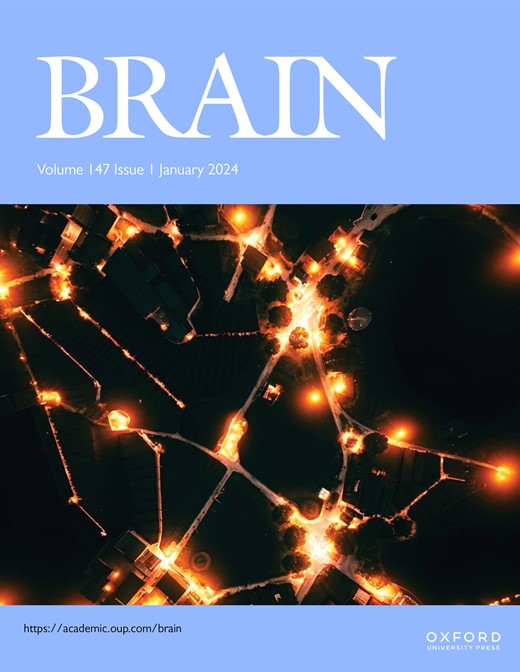急性和慢性脱髓鞘引发的血液和组织中轴索损伤的标志物
IF 10.6
1区 医学
Q1 CLINICAL NEUROLOGY
引用次数: 0
摘要
神经轴突损伤是脱髓鞘疾病中不可逆残疾的主要驱动因素。准确评估脱髓鞘和轴突病理之间的关系对于评估和开发有效的治疗方法至关重要。测量血液中的神经丝轻链(NfL)可以在“单蛋白分辨率”下对神经轴突损伤进行纵向监测,具有很高的病理特异性。在这里,我们证明了在实验性自身免疫性脑炎(EAE)中,基于血液和组织nfl的神经轴突损伤评估与炎症性脱髓鞘严重程度之间存在强大的关联。在EAE中,当使用针对相同NfL表位的抗体时,高水平的NfL在脱髓鞘高峰时是明显的,并且与NfL丢失的组织证据相关。此外,我们在炎症非依赖性髓磷脂损失的诱导遗传模型中验证了纵向NfL动态与脱髓鞘和再髓鞘形成的关系。通过诱导敲除Myrffl/fl PLP1-CreERT (MyrfΔiPLP)小鼠的蛋白脂蛋白(PLP)表达细胞中的髓磷脂调节蛋白(Myrf),血清NfL在脱髓鞘时达到峰值,在有效的髓鞘再生后降低。在多发性硬化症(最常见的脱髓鞘疾病)患者中,我们在两个独立的队列中使用Olink接近扩展试验、ReBUILD临床试验和UK-Biobank中的MS参与者证实了NfL和髓磷脂分解蛋白之间的关联。我们的研究为理解脱髓鞘和髓鞘再生背景下NfL变化背后的生物学提供了一个翻译框架,并揭示了与监测人类和啮齿动物中潜在可逆神经轴突病理相关的新方面。本文章由计算机程序翻译,如有差异,请以英文原文为准。
Markers of axonal injury in blood and tissue triggered by acute and chronic demyelination
Neuroaxonal injury is a major driver of irreversible disability in demyelinating conditions. Accurate assessment of the association between demyelination and axonal pathology is critical for evaluating and developing effective therapeutic approaches. Measuring neurofilament light chain (NfL) in blood could putatively allow longitudinal monitoring of neuroaxonal injury at “single protein resolution” with high pathological specificity. Here, we demonstrate a robust association between blood and tissue NfL-based assessment of neuroaxonal injury and severity of inflammatory demyelination in experimental autoimmune encephalitis (EAE). In EAE, high levels of NfL were evident at peak of demyelination and correlated with tissue evidence of NfL loss when using antibodies that target the same NfL epitopes. In addition, we validate the longitudinal NfL dynamics in relation to de- and remyelination in an inducible genetic model of inflammatory-independent myelin loss. Through inducible knockout of myelin regulatory protein (Myrf) in proteolipid protein (PLP) expressing cells in Myrffl/fl PLP1-CreERT (MyrfΔiPLP) mice, serum NfL peaked at time of demyelination and were reduced following effective remyelination. In people with multiple sclerosis, the most common demyelinating condition, we confirmed the association between NfL and myelin breakdown proteins in two independent cohorts using Olink proximity extension assays, the ReBUILD clinical trial, and the MS participants in the UK-Biobank. Our study provides a translational framework to understand the biology behind NfL changes in the context of de- and remyelination and reveals novel aspects related to monitoring potentially reversible neuroaxonal pathology in humans and rodents.
求助全文
通过发布文献求助,成功后即可免费获取论文全文。
去求助
来源期刊

Brain
医学-临床神经学
CiteScore
20.30
自引率
4.10%
发文量
458
审稿时长
3-6 weeks
期刊介绍:
Brain, a journal focused on clinical neurology and translational neuroscience, has been publishing landmark papers since 1878. The journal aims to expand its scope by including studies that shed light on disease mechanisms and conducting innovative clinical trials for brain disorders. With a wide range of topics covered, the Editorial Board represents the international readership and diverse coverage of the journal. Accepted articles are promptly posted online, typically within a few weeks of acceptance. As of 2022, Brain holds an impressive impact factor of 14.5, according to the Journal Citation Reports.
 求助内容:
求助内容: 应助结果提醒方式:
应助结果提醒方式:


